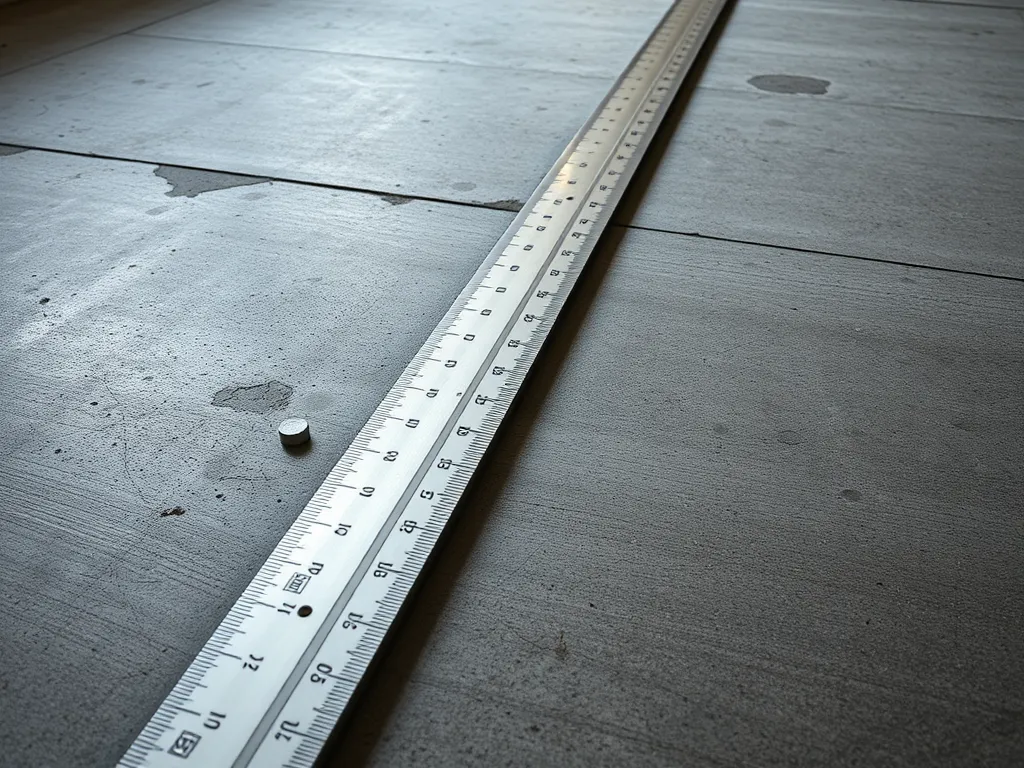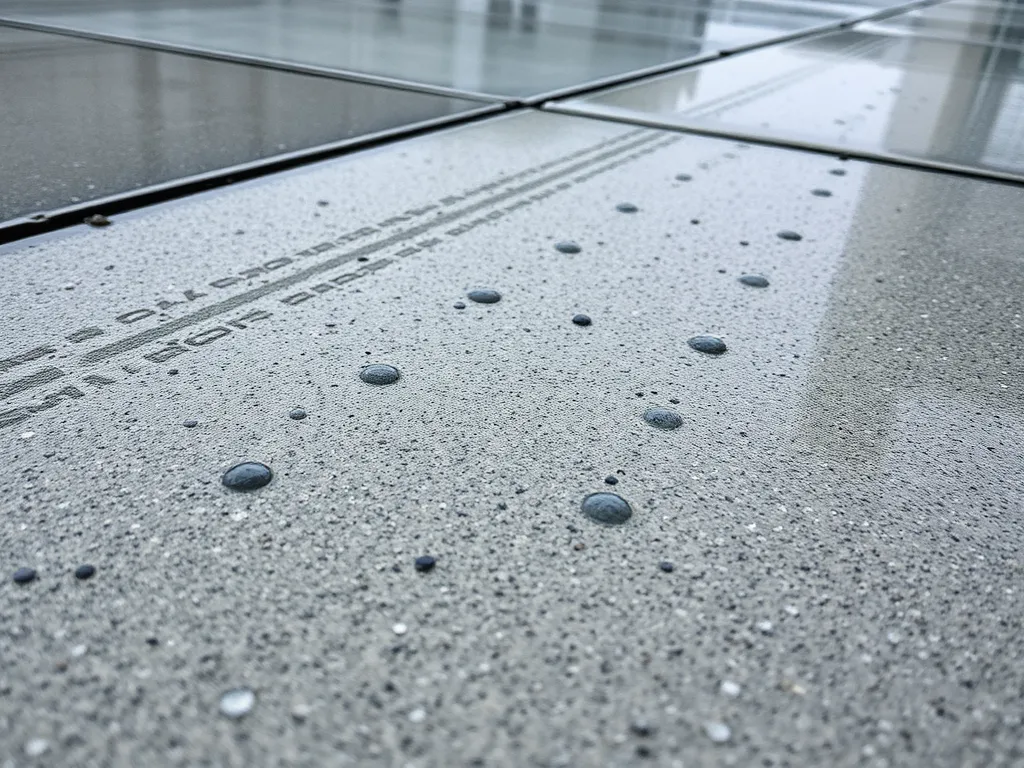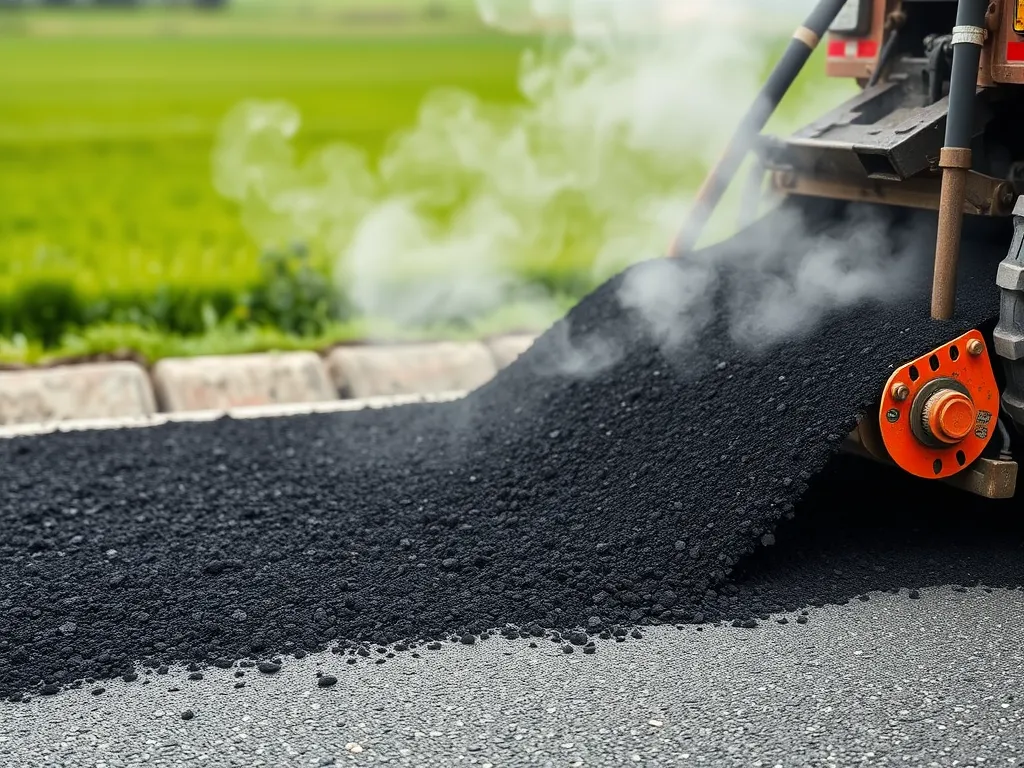Can You Put Asphalt Over Broken Concrete? A Practical Guide
Published on: October 6, 2025 | Last Updated: April 14, 2025
Written By: George Voss
Yes, you can install asphalt over broken concrete if the base meets specific stability requirements. Successful overlays require crack widths under 1/4 inch, proper surface preparation, and a minimum 2-inch asphalt layer. Costs range from $3 to $7 per square foot, with drainage fixes and bonding agents like SS-1h emulsion boosting adhesion. Projects demand careful evaluation of concrete movement and compaction at 300°F for optimal density.
This guide tackles real-world scenarios: when to overlay versus remove concrete, cost-saving material calculations, and fixing common failures. You’ll get step-by-step assessments for cracks, slope adjustments (1-2% grade recommended), and thickness specs for driveways versus parking lots. We compare reflective crack risks against full removal expenses and share contractor-grade tips for lasting results.
Contents
- Understanding the Feasibility Of Asphalt Over Broken Concrete
- Assessing Your Concrete Surface
- Preparation Steps for Asphalt Over Concrete
- Installation Process for Asphalt Over Concrete
- Cost Considerations for Asphalt Overlays
- Benefits Of Choosing Asphalt Over Concrete
- Potential Issues With Asphalt Over Concrete
- Environmental Considerations
- Frequently Asked Questions (FAQ)
- Closing Thoughts
- Additional Resources for You:
Understanding the Feasibility Of Asphalt Over Broken Concrete
Overlaying asphalt on broken concrete works best when specific engineering factors align. This method saves 40-60% versus full removal but demands precise surface evaluation and prep work.
Key Factors for Successful Asphalt Overlays
Three elements determine overlay success: existing slab stability, material compatibility, and drainage efficiency. Missing one risks reflective cracking or premature failure within 2-5 years.
Condition of Existing Concrete: Cracks, Stability, and Drainage
Concrete slabs with cracks over 1/4″ wide or vertical offsets exceeding 1/2″ typically need stabilization. Geogrids or polymer-modified leveling compounds fix unstable bases. Ensure 1-2% slope for water runoff – ponding water beneath asphalt causes rapid deterioration.
Asphalt’s Flexibility vs. Concrete’s Rigidity
Asphalt expands/contracts at 20x concrete’s rate (0.0000065 vs. 0.000013 per °F). This mismatch causes stress without proper bonding agents. Tack coats (SS-1h emulsions at 0.05 gal/sy) bridge materials, allowing 300-500% more flex than concrete alone.
Next, we’ll examine how to assess your specific concrete surface for these critical overlay requirements.
Assessing Your Concrete Surface
Proper evaluation determines whether your concrete base can support an asphalt overlay. Missing this step risks premature cracking, uneven surfaces, and drainage failures in your new pavement.
Evaluating Crack Severity
Crack width and depth dictate repair strategies. Use a ruler or caliper to measure openings before deciding on next steps.
Small Cracks (Less than 1/4 inch)
Hairline fractures under 1/4 inch wide rarely threaten asphalt overlays. Clean debris with compressed air, then fill cracks using PG 64-22 asphalt binder or rubberized crack sealant ($1.50-$3 per linear foot). These materials flex with temperature changes, preventing reflective cracks.
Large Cracks and Structural Damage
Gaps exceeding 1/4 inch signal deeper issues. Probe cracks with a screwdriver—if edges crumble or subgrade soil is visible, the slab likely needs partial replacement. Heaved sections or settlement exceeding 1 inch often require full-depth concrete repairs ($8-$12 per sq ft) before asphalt installation.
Identifying Uneven Surfaces and Drainage Issues
Asphalt mirrors every dip and bulge in the concrete below. Place a 10-foot straightedge across the surface—gaps over 3/8 inch demand correction. Check slope with a laser level: existing concrete must have at least 2% cross-slope (1/4 inch per foot) to prevent water pooling under the asphalt. Milling high spots ($1.50-$3 per sq ft) and filling depressions with cold patch asphalt creates a stable base.
With surface conditions verified, the real work begins—transforming flawed concrete into a reliable foundation for your asphalt layer.

Preparation Steps for Asphalt Over Concrete
Transforming a broken concrete base into a smooth asphalt surface starts with rigorous groundwork. Skipping vital prep work risks cracks, poor adhesion, and rapid asphalt failure.
Cleaning and Degreasing the Surface
Start with a high-pressure wash (3,000-4,000 PSI) to blast off dirt, loose chunks, and oil stains. Oil contamination above 2% stops asphalt bonding. Apply trisodium phosphate or industrial degreasers to stubborn spots. Let it dry fully – moisture traps under asphalt cause cracks in cold months.
Repairing Concrete Substrate
Fix flaws in your base before laying asphalt. Ignoring cracks or uneven spots lets stress points shift into your new layer.
Filling Cracks with Asphalt-Compatible Materials
Use polymer-modified asphalt emulsion for gaps up to 1.5 inches wide. This hot-pour material flexes with temperature shifts, stopping crack reflection. For splits wider than 2 inches, cut out damaged parts and patch with Class 2 aggregate base. Compact fills with a 90-lb plate compactor to 95% density.
Grinding High Spots and Leveling Depressions
Run a diamond grinding wheel over raised joints or slabs. Aim for surface variations under 1/8 inch per 10 feet. Fill low zones with cold mix asphalt or leveling course material. Slope must maintain at least 2% grade for drainage – standing water cuts asphalt lifespan by half.
Applying Bonding Agents for Adhesion
Spray SS-1h asphalt emulsion at 0.15-0.25 gallons per square yard. This tack coat bonds fresh asphalt to old concrete, boosting shear strength by 40-60%. Time application within 24 hours of paving – delayed installation lets dust coat the glue layer. For driveways with heavy cracks, add fiberglass grid interlay ($1.50-$2.75/sq.yd.) to stop reflective splits.
With your base solid and clean, focus shifts to asphalt mix selection and compaction tactics for lasting results. Up next: installation protocols that lock in your hard prep work.
Also See: Does Asphalt Driveway Increase Property Value?
Installation Process for Asphalt Over Concrete
Applying asphalt on a broken concrete base follows strict protocols. Skipping vital steps risks cracks mirroring through your new pavement within months.
Proper Asphalt Thickness Requirements
Thickness impacts load capacity and crack resistance. Thin layers fail quickly on rigid bases. Follow industry norms based on usage.
Minimum 2-3 Inches for Driveways
Home driveways need 2-3 inches of hot mix asphalt (HMA). This allows minor substrate shifts without surface splits. Thinner coats below 2 inches risk raveling under car tires.
Commercial Surface Specifications
Parking lots and roads require 4+ inches over concrete. Heavy trucks apply 80-100 psi force – thicker asphalt distributes weight better. ASTM D3515 mandates 4-inch minimum for commercial overlays.
Compaction Tactics for Long-lasting Outcomes
Density matters most. Under-compacted asphalt won’t bind properly to concrete. Use vibratory rollers hitting 92-96% density via nuclear gauges.
| Roller Type | Passes Needed | Temp Range |
|---|---|---|
| Vibratory | 4-6 | 275-225°F |
| Static | 8-10 | 250-200°F |
Start rolling at 275°F for optimal particle alignment. Focus on joints – weak spots where cracks form first.
Getting thickness and compaction right affects what you’ll pay long-term. Next, we break down pricing factors for overlays versus full replacements.

Cost Considerations for Asphalt Overlays
Installing asphalt over broken concrete saves money compared to full demolition but requires smart budgeting. Prices swing based on surface prep needs and regional material rates.
Price Range Per Square Foot
Expect $2.50-$4.50 per square foot for residential projects. This covers 2-3 inches of asphalt and standard prep work. Commercial jobs with thicker layers (4+ inches) hit $3.75-$6.25. Broken concrete needing extensive repairs adds 15-30% to these rates. For example, a 1,000 sq ft driveway ranges from $2,500 to $6,250 before extras like drainage fixes.
Using an Asphalt Calculator for Material Estimates
Input your project’s length, width, and desired thickness into an asphalt calculator. A 10’x50’ driveway needing 3” coverage requires roughly 12.5 tons (1 ton covers 40-80 sq ft at 2-3” depth). But calculators often miss two critical factors:
- Waste allowance (add 5-10% for irregular surfaces)
- Bonding agents ($0.15-$0.30 per sq ft for tack coat)
Accounting for Base Preparation Costs
Prep eats 30-40% of total budgets when laying asphalt over damaged concrete. Common tasks:
- Crack filling: $1.20-$3.00 per linear foot for asphalt-emulsion sealants
- Grinding high spots: $0.50-$1.50 per sq ft
- Milling: $0.75-$3.00 per sq ft for severely uneven slabs
Skip these steps, and you’ll face premature cracks – repairs cost triple the initial savings within 2-3 years.
Smart planning balances material costs with surface adjustments. Next, let’s explore why this investment pays off in long-term performance.
Benefits Of Choosing Asphalt Over Concrete
Installing asphalt over broken concrete offers distinct perks versus leaving concrete exposed or replacing it entirely. The process combines the strength of existing concrete with the resilience of fresh asphalt layers.
Weather Resistance and Crack Flexibility
Asphalt overlays handle temperature shifts better than rigid concrete. Bitumen-based mixes expand during summer heat without buckling. In winter, they contract slightly, resisting freeze-thaw damage. PG (Performance Graded) binders in modern asphalt formulations flex around minor substrate cracks up to 1/8 inch wide.
Lower Maintenance Compared to Bare Concrete
Maintaining bare concrete demands frequent joint resealing or crack repairs costing $1.50-$3 per linear foot. Asphalt surfaces need only biennial sealcoating at $0.15-$0.25 per square foot. Overlays prevent water intrusion into fractured concrete bases, slowing further degradation by 60-70% based on Federal Highway Administration studies.
Improved Traction and Safety
Fresh asphalt provides skid resistance values of 50-60 SN (Skid Number) versus worn concrete’s 30-40 SN. The textured surface improves tire grip during rain, cutting hydroplaning risks by 40% according to Texas DOT research. For driveways with steep slopes (over 12% grade), overlays boost stopping traction significantly.
While overlays solve multiple issues with fractured concrete, they’re not universally suitable. Next, we’ll examine scenarios where this method might create new complications.

Potential Issues With Asphalt Over Concrete
Laying asphalt on top of broken concrete carries risks if not done right. Two critical problems can impact long-term results: cracks mirroring flaws in the base and water pooling from poor runoff.
Reflective Cracking From Substrate Movement
Asphalt’s flexibility fights against rigid concrete slabs. When slabs shift from frost heave, soil settling, or traffic loads, stress forms in the overlay. This causes mirror-image cracks called “reflective cracking” – visible within 12-24 months in 60% of projects without proper prep. High spots in concrete slabs worsen this by creating pressure points.
| Causes | Solutions |
|---|---|
| Slab gaps over 1/4″ | Apply fiberglass grid ($1.50-$3/sq ft) |
| Unstable subgrade | Install 4″ compacted stone base |
| No bonding agent | Use PG 64-22 binder for adhesion |
Drainage Challenges in Flat Concrete Bases
Original concrete slabs built without slope (less than 2% grade) trap water under asphalt. This leads to:
- Potholes from frost action in northern climates
- Raveling (surface erosion) within 3-5 years
- Base layer saturation reducing load capacity
Fix drainage by milling 1/4″ per foot slope into existing concrete or adding trench drains. For driveways, a 3% cross-slope (0.36 inches per foot) stops ponding at edges.
Up next: How reusing old materials and smart paving choices can shrink your project’s footprint.
Environmental Considerations
Laying asphalt over broken concrete cuts waste and saves energy. Let’s break down two key eco-benefits.
Recycling Existing Concrete As Base Material
Crushed concrete makes a strong base for asphalt. Broken slabs get ground into 1-3 inch chunks (called RCA) under rollers. This reuse keeps 8-10 tons per 100 sq ft out of landfills. ASTM D2940 approves RCA for base layers under asphalt over concrete driveways.
Using old concrete cuts costs 15-30% vs new gravel. It also lowers truck trips – recycling onsite saves 4-6 hauls per project. Just cap RCA with 2 inches of compacted stone dust before paving.
Energy Efficiency Of Asphalt Production
Asphalt plants use 20% less energy than concrete mixers. Key numbers:
- Asphalt cooked at 250-325°F vs 1500°F for cement
- 60% of U.S. asphalt contains recycled material
- Warm-mix tech cuts fuel use by 20%
Overlays need 40% less raw material than full rebuilds. New asphalt over cracked concrete driveways uses 99% recycled heat from plant burners. RAP (reused asphalt) blends save 2.5 barrels of oil per ton.
These green perks stack up – but what about costs? Let’s crunch the numbers…

Frequently Asked Questions (FAQ)
Can I Put Asphalt Over Cracked Concrete?
Yes, asphalt can be placed over cracked concrete, but it is essential to assess the severity of the cracks. Small cracks (less than 1/4 inch) can typically be filled and covered, while larger cracks may require significant repairs prior to installation to prevent reflective cracking in the asphalt overlay.
Will Asphalt Coating Stick to Concrete?
Asphalt can bond effectively to concrete if proper surface preparation is undertaken. This includes cleaning the concrete thoroughly, filling any significant cracks, and applying a bonding agent, which enhances the adhesion between the two materials.
What Preparation Ensures Proper Bonding?
To ensure proper bonding of asphalt over concrete, clean the surface thoroughly to remove any debris, oil, and contaminants. Additionally, fill existing cracks with asphalt-compatible materials and apply a bonding agent according to manufacturer’s specifications prior to laying the asphalt.
How Does Cost Compare to Full Concrete Replacement?
Installing asphalt over broken concrete is generally more economical than full concrete replacement, offering savings of 40-60%. The cost for asphalt overlays typically ranges from $3 to $7 per square foot, depending on preparation needs, while concrete replacement can significantly exceed this, especially with extensive repairs.
Closing Thoughts
Putting asphalt over broken concrete can be a practical and cost-effective solution if certain criteria are met. Assess the condition of your existing concrete thoroughly. Repair significant cracks and ensure proper drainage to avoid future complications.
During installation, follow the specified thickness and compaction techniques to achieve a durable surface. Remember that while asphalt can provide benefits such as weather resistance and improved traction, potential issues like reflective cracking must be addressed.
For tailored insights on your project, visit Asphalt Calculator USA. Get precise estimates and make informed decisions. Your paving journey starts with the right information!
Additional Resources for You:
- American Association of State Highway and Transportation Officials (AASHTO). (2008). Mechanistic-Empirical Pavement Design Guide (MEPDG). Washington, DC: AASHTO.
- What are the Side Effects of Paving Asphalt over Concrete?
- blacktop driveway over concrete
- Can You Put Asphalt Over Concrete?
- Can You Put Asphalt Over Concrete? – Asphalt Driveway Paving


